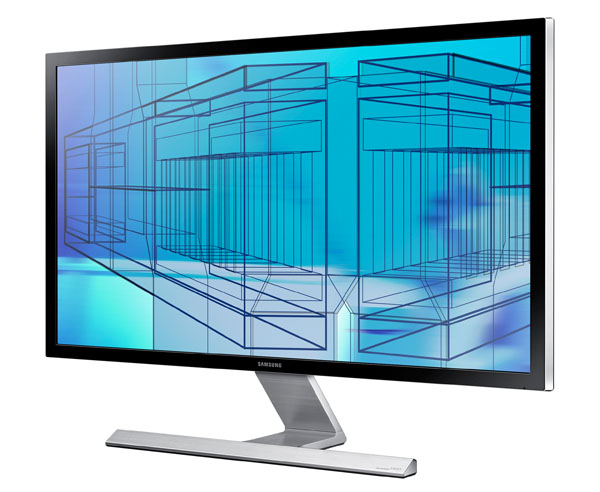Early Verdict
Supply and demand has created numerous choices in the Ultra HD monitor category. Even though five different brands all use the same panel part, they do not perform the same. Samsung stands out from the pack with accurate color and an image enhancement feature that successfully improves off-axis image quality. The U28D590D is one of our favorite high-res displays thus far.
Pros
- +
Value
- +
brightness
- +
excellent calibrated performance
- +
MagicAngle improves off-axis viewing
Cons
- -
No height or swivel adjustment
- -
no VESA mount
- -
no USB hub
Why you can trust Tom's Hardware
Samsung U28D590D 28-Inch Ultra HD Monitor Review
The first generation of Ultra HD monitors landed definitively in the flagship product category. With prices north of $3000, those first three IGZO-based screens from Asus, Dell and Sharp were only likely to find their way into professional studios or the offices of corporate executives. You can find all three of them for less money today, but in most cases, they still cost as much as the rest of your components put together.
Asus changed the segment enormously when it unveiled the PB287Q back in May of 2014. Suddenly you could buy a 4K screen for only $600. The only downsides were that the panel was four inches smaller and it employed old-school TN technology. Despite that, it inspired other major manufacturers to craft their own versions. Today we’re looking at the fifth such display in our lab: Samsung’s U28D590D.
| Brand & Model | Samsung U28D590D |
|---|---|
| Panel Type & Backlight | TN / W-LED, edge array |
| Screen Size & Aspect Ratio | 28in / 16:9 |
| Max Resolution & Refresh Rate | 3840x2160 @ 60Hz |
| Native Color Depth & Gamut | 10-bit (8-bit+FRC) / sRGB |
| Response Time (GTG) | 1ms |
| Brightness | 370cd/m2 |
| Speakers | - |
| Video Inputs | 1 x DisplayPort, 2 x HDMI |
| Audio | 3.5mm headphone output |
| USB | - |
| Panel DimensionsWxHxD w/base | 26 x 19.1 x 6.7in655 x 481 x 169mm |
| Panel Thickness | 1.9in / 47mm |
| Bezel Width | .5in / 12mm |
| Weight | 12.4lbs / 5.6kg |
| Warranty | Three years |
Based on the same Innolux (formerly Chi Mei Optoelectronics) panel as its competitors, the U28D590D offers pretty much the same specs. Rated at 370cd/m2, it’s actually a tad brighter than the others, as demonstrated in our benchmarks. It runs at a full 60Hz over DisplayPort and is limited to 30Hz with an HDMI connection. Color depth is 10-bits, though this is achieved using frame rate conversion on an 8-bit signal. Users concerned about banding can rest assured that we saw no examples of that artifact during our time with the display.
Even though 10-bit color is a professional bit of credibility, this class of monitor is most likely to appeal to gamers looking for ultimate graphics quality. We’ve all seen the debates about how much graphics processing power is required to make this happen, so we won’t rehash that here. Suffice it to say that some players prefer higher pixel density over speed. It all depends on what titles you have in your library and just how fast your reflexes are.
If you need blistering frame rates and perhaps would like to eliminate screen-tearing artifacts, Ultra HD may not be the right choice. The limitations of both HDMI and DisplayPort mean that 60Hz is all you get for the time being. Of course you can get G-Sync and 4K in the Acer XB280HK. We’re working on getting a press sample now and expect to review it soon.
For non-GeForce users, however, a fast refresh rate is a must. And until we see wider implementation of DisplayPort 1.3 and HDMI 2.0, monitors like the U28D590D are the best available solution for enthusiasts eager to experience higher pixel density.
Even though the five 28-inch Ultra HD monitors we’ve reviewed are based on the same panel part, they are not equal in all areas of performance. The decision about which one to purchase will come down to what metric matters to you most. Let’s take a look.
Get Tom's Hardware's best news and in-depth reviews, straight to your inbox.
Current page: Samsung U28D590D 28-Inch Ultra HD Monitor Review
Next Page Packaging, Physical Layout And Accessories
Christian Eberle is a Contributing Editor for Tom's Hardware US. He's a veteran reviewer of A/V equipment, specializing in monitors. Christian began his obsession with tech when he built his first PC in 1991, a 286 running DOS 3.0 at a blazing 12MHz. In 2006, he undertook training from the Imaging Science Foundation in video calibration and testing and thus started a passion for precise imaging that persists to this day. He is also a professional musician with a degree from the New England Conservatory as a classical bassoonist which he used to good effect as a performer with the West Point Army Band from 1987 to 2013. He enjoys watching movies and listening to high-end audio in his custom-built home theater and can be seen riding trails near his home on a race-ready ICE VTX recumbent trike. Christian enjoys the endless summer in Florida where he lives with his wife and Chihuahua and plays with orchestras around the state.
-
mgilbert Correction - I wound up with R=49, G=33, B=48. And this monitor is blindingly bright. I have brightness set at 40, contrast at 60, and sharpness at 52.Reply -
Charly2nd "If you want a 32-inch jumbo screen to anchor your high-end rig, you’ll still pay between $1500 and $2000."Reply
This is not true anymore. Benq and Acer bith sell 32inch IPS panels for under U$D1000. Also, Dell' has a 27 inch 4K IPS panel that sells for 700 dollars, but can be found regularly for U$D 500 during promotions. So, there are cheaper IPS options out there (I purchased one for U$D 524 - hasn't arrived yet), almost for the same price of these TN panels. -
airborn824 I have this monitor and i enjoy it, i got it for free. I Would buy the ASUS if it was my own money. Does anyone know if this is also getting Freesync support? I have 2x R9 290Reply -
Charly2nd My correction aside, I like the thoroughness of Christian's reviews. I come often to this site because of hardware reviews like these! Thanks!Reply -
Grognak Eh, TN on such a massive, 4K monitor is kinda counterintuituve. It's true that they're getting better when it comes to both viewing angles and colors, but that's still not quite IPS quality here. Also, the 98ms input lag is insane, most TVs don't go that high. I guess you can't be too demanding at that price.Reply -
Ilander The Amazon link to the PB287Q links to the incorrect product, mistakenly leading me to believe that it was 399.99 USD. That's a huge difference in price which really sets a person's opinion on value...please fix.Reply -
xj97 I had this monitor at work and ended up pawning it off on someone else. The panel was pretty decent, but it did NOT play well with sleep states over displayport. The monitor wouldn't wake up... I'd have to pull the power plug to reset the darn thing.Reply
Other than that I loved it, but the sleep issue was just too annoying. -
ceberle Reply15156989 said:I have this monitor, and am wondering why you tested it on HDMI, which only yields a 30 Hz refresh rate. Would using the DisplayPort input change any of the numbers significantly, especially considering that there is no option to change the black level when on DP? Would using DP affect input lag?
Also, I found the green level much too high out of the box, and my old HueyPro calibrator agreed. I wound up with R=49 G=43 B=48. And, using a couple of gamma test images, I found gamma to be way off. I used the QuickGamma utility to correct it. With these corrections, I have excellent image quality.
When I test monitors with the Accupel signal generator it is indeed over HDMI but since the input resolution is 1920x1080, the tests are run at 60Hz. I have made comparisons of HDMI and DisplayPort with regards to response and input lag and found no difference in speed. Resolution also makes no difference since the panel scales any incoming signal to its native resolution.
-Christian-
-
qlum Looking at these screens I think my upgrade to 4k for my primary monitor is going to wait a while longer. Especially since my 4 screen setup would require a vesa mount.Reply
